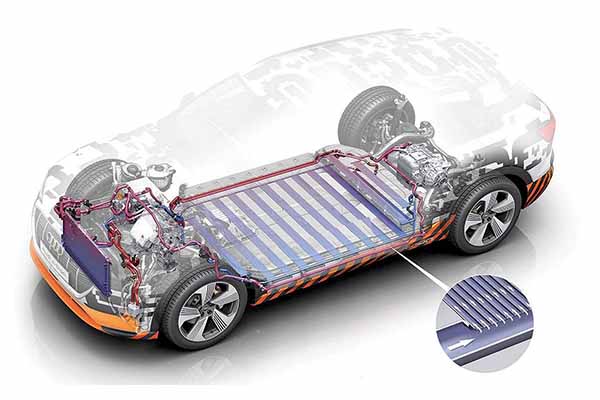Thermal management continues to be a key topic for electric vehicle (EV) design. Early trends in the market largely revolved around the adoption of active cooling for the battery pack, now this is the industry standard. However, batteries, motors, and power electronics in EVs continue to evolve with developments of cell-to-pack designs, directly oil-cooled motors, and silicon carbide power electronics being just a few of the key trends that will impact thermal management strategies across the key driveline components in an EV. As the thermal management market evolves, opportunities arise for materials companies, component suppliers, vehicle designers, and other players in the rapidly growing EV industry.
Battery: cell-to-pack, coolants, thermal interface materials, and fire protection
The key factors for EV battery development are increasing energy density and reducing costs. This has been made more difficult with supply chain shortages, but battery designs are becoming simpler as designers start to remove materials that are not the cells. This strategy culminates in cell-to-pack or cell-to-body designs. Cell-to-pack eliminates strict module housings in favour of having all of the cells stacked together. Cell-to-body makes the battery a structural part of the vehicle. Designs from BYD, Tesla, and others have made it on to the road, with further announced designs coming to market in the near future. With the removal of so much from the pack.
Some active cooling strategies will remain similar, with a large cold plate beneath or above the cells, albeit now in contact directly with cells rather than their module housing. This minor change has a severe impact on thermal interface material (TIM) utilisation pushing in favour of thermally conductive adhesives to make a structural connection rather than the typical gap filler seen in many existing designs. This report forecasts TIM demand for EV batteries to 2023 in terms of mass and revenue, segmented by gap pad, gap filler, and thermally conductive adhesive.
Motors
For electric motors, the magnets used in the rotor and the windings used in the stator must be kept in an optimal operating temperature window to avoid damage or inefficient operation. Water-glycol used in a jacket around the motor has been the standard thermal management strategy for electric motors in EVs. However, recent years have seen much greater adoption of directly oil cooling the motor to provide better thermal performance, and in some cases, eliminate the cooling jacket, reducing the overall motor size. Oil cooling became the dominant form of cooling for EV motors in the first half of 2022, but that’s not to say that water-jackets are going away, they are often used in conjunction with oil cooling, and water-glycol coolant is typically used to remove heat from the oil and can be used to integrate with the vehicles thermal management strategy as a whole. IDTechEx provides a 10 year forecast of electric motors segmented by the use of air, oil, or water-glycol cooling.

Power electronics
The adoption of SiC is the largest trend in the news for EV power electronics and with good justification. The EV market provides a huge addressable market for adoption of the wide bandgap semiconductor to enable higher system efficiencies. This has had an impact on the construction of power electronics packages. Developments are happening for wire bonding, die-attach, and substrate materials, largely with the goal of improving package reliability, especially for wide bandgap semiconductor modules. Many inverter suppliers have now eliminated the TIM between the heatsink and baseplate to improve thermal resistance, although this does not mean there are no TIM opportunities within power electronics. Many components still require a TIM and TIMs are often still used to bond the module heat sink to the water-glycol cold plates. The report provides analysis of these trends and the drivers behind adoption.
Inverter IGBT or SiC MOSFET modules are mostly cooled using water-glycol. However, both single-side and double-sided cooling options are used, each with their own benefits. There has also been an increase in using oil to cool power electronics to eliminate much of the water-glycol componentry within the electric drive unit, using the same oil for the motors and inverter. Whilst there has not been adoption of this approach in the current market, IDTechEx sees promise for this approach and includes a 10-year forecast for EV inverters using air, water, or oil cooling.

Some specific highlights
Battery
- New models added to EV range comparison with ambient temperature.
- Updated market shares of vehicles with a heat pump for 2015-2022H1 and forecast to 2033.
- New chapter on coolant fluids and refrigerants specific for EVs. Some examples of EV thermal architectures are included.
- Updated examples of OEMs utilizing each battery thermal management strategy (air, liquid, refrigerant, and immersion).
- Analysis of thermal management strategy by battery capacity.
- Regional market shares of air, liquid, and refrigerant cooling in China, EU, and the US updated for 2015-2022H1.
- Market shares of air, liquid, and refrigerant cooling depending on cell format (cylindrical, pouch, or prismatic).
Motors
- Analysis of cooling strategy by motor power.
- Market share of cooling strategy by motor type.
- Updated motor thermal management strategies of OEMs.
- Regional market shares of motor cooling strategy (air, oil, water) for China, EU, and the US.
- Global forecast of motor cooling strategy (air, oil, water) until 2033.
- Updated EV motor use-cases.
Power electronics
- Updated power electronics packages from OEMs and inverter suppliers.
- Further examples of single vs double-sided cooling and adoption.
- Slides relating to TIM opportunities now that many have eliminated TIMs between heatsink and baseplate.















